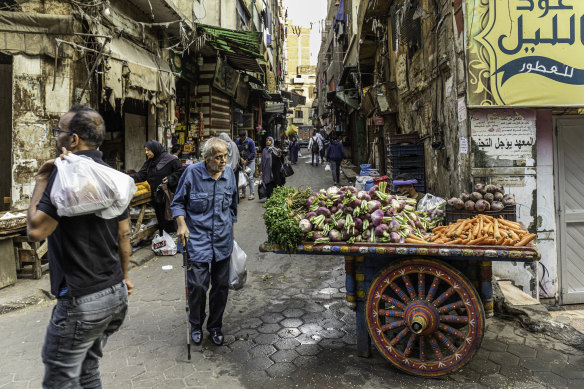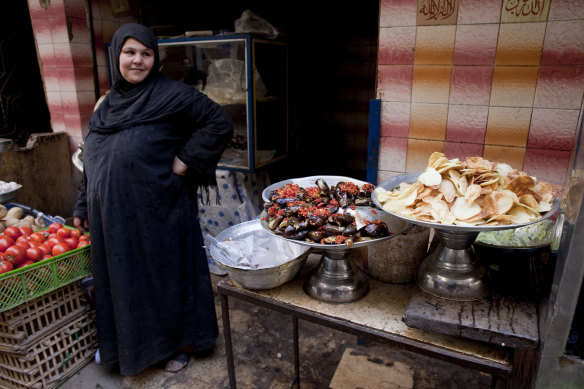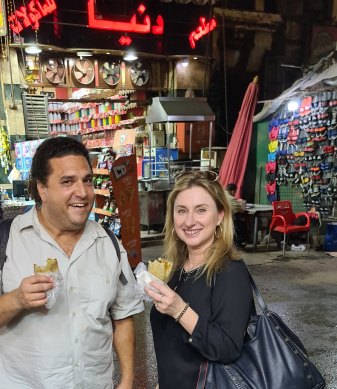It’s ironic that the meeting place for my Cairo walking food tour is Tahrir Square – home of the Egyptian Museum, site of 2011’s revolutionary protests, the epicentre of the city of 22 million and… location of several US burger chains.
Waiting for me is Amir Bishara, a food tour guide for Bellies En Route. Founded by Cairene women Laila Hassaballa and Marian Nezar in 2016, Bellies bucks the Middle Eastern trend of tourism as a male-dominated profession, with five female guides. Amir is just one of the two male guides, and his infectious love of food and street eating soon has the two of us wandering the streets like hungry friends.
When I’d booked my food adventure, the pre-tour notes advised me to skip lunch (and probably breakfast), and to wear good walking shoes to navigate between the five food and three drink stops.

The historic Khan el-Khalili souk, Cairo.Credit: iStock
Stepping past the ads for McArabias and McFalafels, our first stop is a plastic table on the street where we’re served Egypt’s national dish – koshari. A carb-fest of rice, macaroni, spaghetti and lentils, it’s doused with rich tomato salsa, fried onions and a slash of vinegar and chilli. Around us, locals hoover up the dish which was invented by a homesick Italian chef in Egypt’s royal palace, by Egyptian Jews (it’s “kosher” right?) or maybe by migrating Indians.
It’s a heavy start to the tour, but the portions are small, in keeping with Bellies’ no-waste policy, which means: eat it all, or give any untouched food to the poor we meet along the way.
Our next stop is for Arabia’s most famous food export after kebab, falafel. Called ta’ameyya in Cairo, fava beans replace chickpeas, and bushels of fresh coriander turn the patties a pretty green colour inside, toasty golden outside. Fresh from the deep fryer, we eat them while standing on the street along with sandwiches filled with hot ful – the fava beans crushed into a cumin-laden paste - Egypt’s classic, protein-rich breakfast of champions.
Late afternoon in downtown Cairo, the air is thick with the scent of petrol fumes and cardamom, which Egyptians grind into their coffee. Sipping a pick-me-up cup of pale-green Arabian coffee, we admire the grand, neo-Mamluk government building in front of us. Built in 1899, it’s only 26 years older than our cafe, Wardet el Yemen (The Rose of Yemen), which has been roasting beans in busy Bab El Louq since King Fuad I sat on the throne.

Stuffed eggplant and more at a Cairo street stall.Credit: iStock
Lunch, Egypt’s main meal, is served until about 5pm, and the usual clientele of the humble Zahrit El Boustan’s (Flower of Boustan Street) are single men and office workers seeking a home-cooked meal.
Our table is filled with well-used silver bowls bearing flavourful, free-range roast chicken stuffed with green peppers and tomatoes, okra cooked in a tomato stew, hot, flat wheaten bread and rice. Always rice.
On the way out, I ask the gentle old man in the kitchen how long the Zahrit has been there. He shrugs.
“Since Farouk’s time…maybe earlier. I don’t know.”
The louche, lady-loving King Farouk lost his throne in a coup d’état in 1952, but I think Zahrit’s stoves were already hot when he was still but a prince.
You can’t miss Egypt’s juice shops: their doors are festooned with seasonal fruits, and we duck beneath nets of pomegranates, watermelons and pineapples into El Sharbatly juice shop. Here, Amir orders a tasting paddle of juices including sugarcane, tamarind and hibiscus juice, the very Egyptian sobia, a sweet, milky childish drink of powdered rice, coconut and cream, and the world’s best, most vivid juice, tangerine (yusefi in Arabic).
All our stops have been very, very local – no tour groups here. The exception is Felfela, serving Egyptian cuisine since 1959. Well used to tourists, with multi-lingual menus, the walls are lined with photos of Egyptian celebrities and a very youthful Jimmy Carter, who dropped by in 1979.
So far, I’ve eaten lightly, fed Zahrit’s cat and shared our uneaten bread with a woman selling tissues, but Felfela has prepared a feast. Rice with vermicelli, more ta’ameyya, babaghanoug, bessara (a dip of pureed fava beans) and fried eggplant await. But the real dish to try here is molokhiya, which translates poorly as Jew’s mallow, a type of spinach. It’s minced into a viscous, hyper-garlicky soup that’s poured over rice. A good molokhiya will bring homesick Egyptians to tears.
“And you have to come back for the stuffed pigeon,” advises Amir. The quail-sized birds are stuffed with mint-infused rice, a true delicacy that requires the time that this tour can’t accommodate.
It’s a much-needed, 15-minute walk across town to Orabi, for dessert at El Falero, which has been making Arabic sweets since 1962. The white-coated, middle-aged men behind the counter are expecting us, and create a plate with little deep-fried zalabia balls soaked in sugar syrup, fingers of custardy goulash stuffed with nuts, a crumbly cookie delightfully named omoosh el set (“lady’s eyelashes”).

Bellies En Route guide Amir Bishara with the author on their food tour.
At this point, I’m surreptitiously edging my waistband down, but my stomach is still lured by the fruit carts in nearby Orabi Square. Owais, sukari, alFons and fas are just a few of Egypt’s 32 types of mango. This bountiful fruit market morphs into a used car-parts market haunted by Cairo’s grease monkeys, and is good for cheap eats, including our final taster, feteer. The flat, round flaky pastry is best eaten hot off the grill and drizzled with treacle.
My tour ends at the historic Hotel Carlton. Built in 1935, the receptionist is of the same vintage. Its rooftop bar has locally brewed Sakara beer served so cold, it gives instant brain freeze. After six hours of walking, talking and eating, it is beyond welcome.
And five floors below, the city continues to eat.
The Downtown Cairo food tour with Bellies En Route costs $A120 a person, including all tips, food and drinks. See belliesenroute.com
Belinda Jackson was a guest of Bellies En Route.
Sign up for the Traveller Deals newsletter
Get exclusive travel deals delivered straight to your inbox. Sign up now.